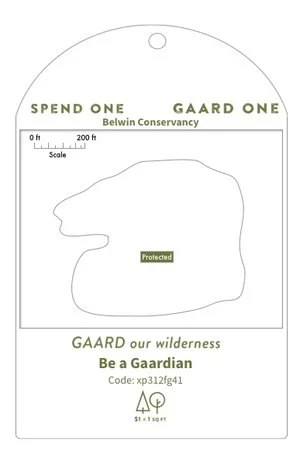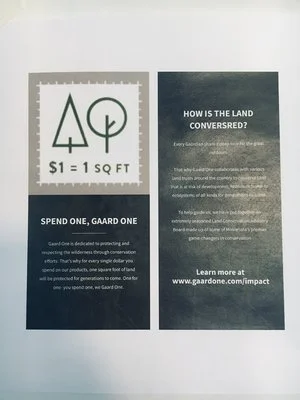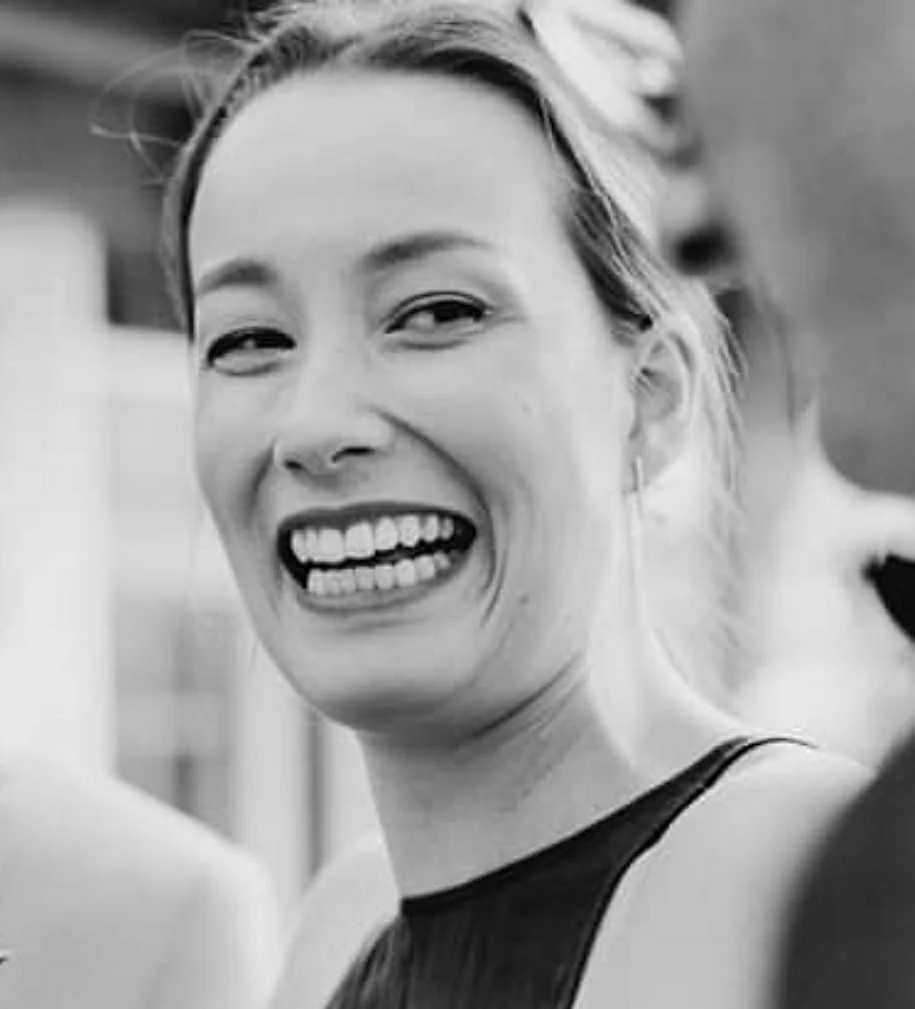GAARD ONE
Opportunity space
Develop a multi-touchpoint design strategy that shifts customer focus to GAARD One’s mission of land conservation.
Solution
Easy entry point in the form of a sticker that allows the customer to contribute to the conservation efforts
An online community/network that allows customers to share their conservation efforts and invite others to join in their efforts as well.
Methods
Client interview
Competitive analysis
Development of guiding Strategy Statement
Touchpoint map
Prototyping
Video presentation
Strategy map
Skills & Tools
Dynamic collaboration
Visual communication
Axure RP
Sketch
iMovie
Pen & paper
Meeting the client
GAARD ONE is a local B-corp that sells outdoors gear for the 21st century outdoors-person. They approached our team to ask that we devise a design strategy to shift the focus of their business from their products to their mission of conserving land at risk of development. Their mission is to conserve 1 square foot of land for every dollar that is spent on their products. In order to better understand the goals, we interviewed Nate Heegaard (Chief Outdoors Officer) and Will Heegaard (Chief Impact Officer). While meeting with them one message came through loud and clear:
“We want the person to feel like they are a part of the mission, not just contributing to it.” -Nate Heegaard
A short competitive analysis was completed with a focus on how each company engaged their products on digital platforms.
diving into the opportunity space
To begin, our team decided to dive into the opportunity space by exploring GAARD One’s touchpoints, along with other similar companies. In order to maximize efficiency, we split up the responsibilities. My job included completing a deep dive into how GAARD ONE engaged their products online, along with how other similar companies did the same. From this we were able to better understand what GAARD ONE was doing and how they were doing it.
Our guide
Using the information that we collected, along with two key hypotheses about the users, we were able to create a guiding strategy statement.
Key Hypotheses:
Urban outdoor day-trippers want to make a visible/tangible change on Earth.
Consumers create strong relationships with meaningful brands.
Guiding strategy statement:
All user experience touchpoints for GAARD One will help eco-friendly, urban, outdoor day-trippers to feel altruistic and active so they are able to increase well-being. We will do this by focusing on connecting mission to user and establishing a close brand-consumer relationship.
Conceptualization
Our team decided that there was an opportunity to cultivate a sense of community in order to engage the consumers in the mission. This led us to believe that a community of like-minded conservationists could find it’s roots in this company. However, we first needed to plant the seed that would eventually grow into this community further down the road. We needed an easy way to spread awareness of the company, while introducing the consumers to their mission. Our solution was a simple $1 sticker. The inexpensive product allows consumers to conserve 1 square foot of land. Additionally, stickers get placed in a variety of places and acts as a simple way to spread awareness of the company and their mission.
This sticker would be sold for $1 and conserve 1 square foot of land
Again, we divided responsibility and decided to jump into prototyping. Specifically, my responsibility was to prototype a package and an interactive map. The goal of the packaging was to engage the conservation mission at the product level. Ultimately, we decided to focus on other touchpoints that better fit our strategy, so the packaging was not advanced beyond a concept sketch. The interactive map was to be placed on the website and allow customers to find the land that they helped to conserve. This would allow for an increase in the customers’ awareness of the tangible difference they were making.
Concept sketch of GAARD One packaging.
An interactive map that allows the user to find the land that they conserve by purchasing products.
The interactive map prototype zoomed in on a specific conservation area. The green box shows the specific land that was conserved by the purchase of a product.
touchpoints and further involvement
With the sticker acting as the foundation for a launch-point, we developed a series of touch points to bridge the consumer and the mission. A brochure was put together that emphasized the conservation efforts. The brochure was meant for distribution at trade shows, and to be included in the packaging of their products. Along with the brochure, each product would come with a specially designed tag that helped identify a specific plot of land that the purchase of that product would help conserve. Consumers could do this by going onto GAARD ONE’s website and entering the code on their tag. An interactive map would display the land they are conserving and would also be able to display all of the land that GAARD ONE is working to maintain.
This tag holds identifying information for the land that was conserved with a specific purchase.
A educational brochure was made with the intention to help the consumer understand the impact they are making.
A flow of touch points was developed to help us visually understand the path of a consumer.
BEcome a gaardian
Once consumers are able to see the land, we needed a way to keep them involved. We believe that developing a “GAARDIAN” program which invites all consumers to join a network of conservationists would strengthen sustainability. This network would allow members to create and share events or meetups centered around the goal of conserving land. The GAARDIAN program engages the consumer beyond their purchase.
Wireframes for the community pages hosted on GAARD ONE’s website.
How to move forward
With a strategy in mind, we needed to decide how to roll out the touchpoints. Below is a strategy map that I created in order to guide the strategy implementation.
A strategy map was developed to help set tangible goals and suggestions for measuring success.
meet the strategy team
Left to right: Sean Kwon, Justin Cookle, Simone Quach Hougaard, Mitch Ryks
Our team worked together to create an environment that promoted open dialogue, and creative problem solving. I believe we were overwhelmingly successful at making each member feel enabled to be the best strategist possible. Novel ideas were welcomed with open minds and respectful collaboration.













